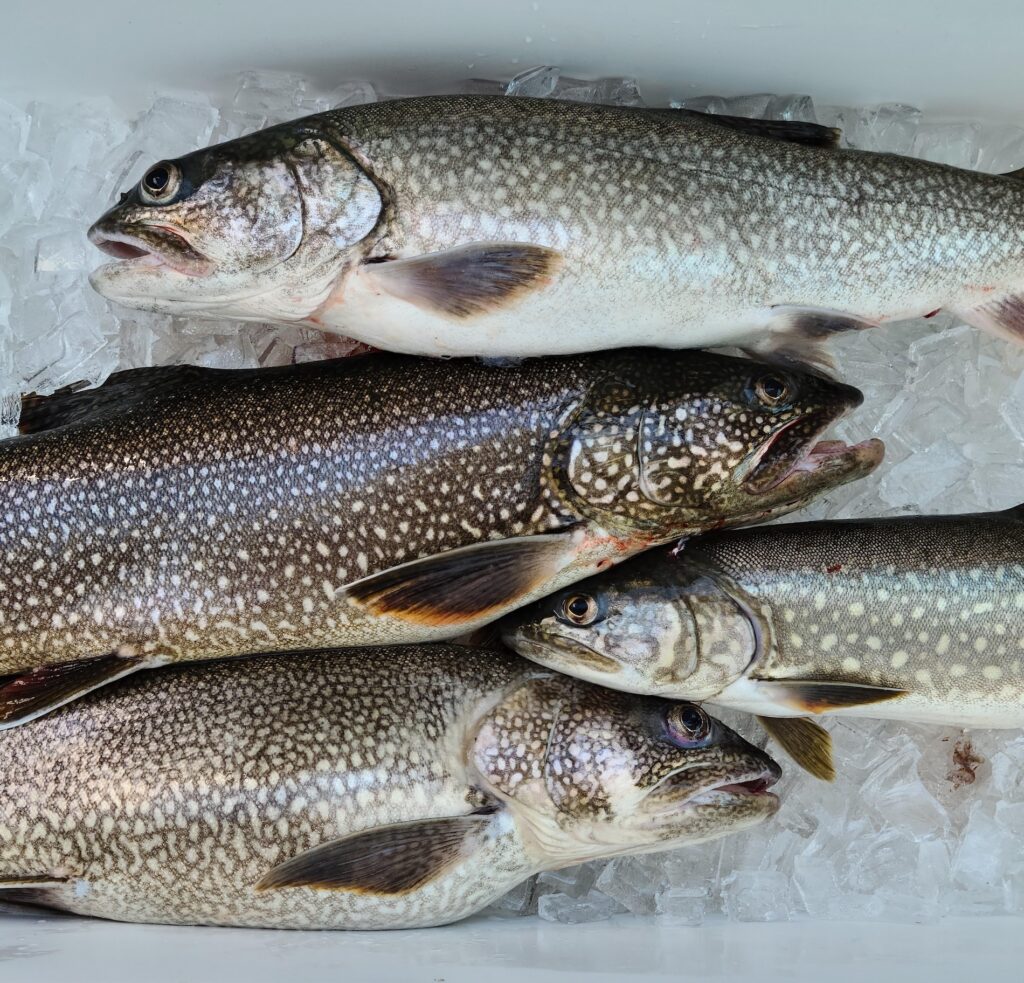
Lake trout caught in Lake Superior on Isle Royale National Park. Image credit: Marie Zhuikov, Wisconsin Sea Grant
A major milestone was recently reached in fisheries management on Lake Superior. The Lake Superior Committee announced that lake trout are fully recovered in most of Lake Superior. The LSC is coordinated under the auspices of the Great Lakes Fishery Commission, consists of fishery managers from the three Great Lakes States (Minnesota, Wisconsin and Michigan) that border Lake Superior, from the Province of Ontario, and from U.S. Tribes represented by the 1854 Treaty Authority, Chippewa-Ottawa Resource Authority, Great Lakes Indian Fish and Wildlife Commission, and the Red Cliff Band of Lake Superior Chippewa Indians.
In the mid-1900s, lake trout populations declined to extremely low levels in Lake Superior due to extensive overfishing and the devastation wrought by non-native, predatory sea lamprey. Through the 1954 Convention on Great Lakes Fisheries, the Governments of Canada and the United States came together to form the Great Lakes Fishery Commission; the commission was charged with controlling sea lamprey, coordinating fishery management and conducting lake trout rehabilitation, which was initiated on a small Lake Superior tributary, Mosquito Creek, in 1958. Successful control of sea lamprey allowed additional management efforts, such as strict harvest regulations and stocking of various strains of lake trout, to be implemented. Together, these efforts were successful and allowed the LSC to substantially reduce stocking in the mid-1990s due to increased abundance of naturally reproducing lake trout populations.
“The decline and near extinction of native lake trout resulted in a drastic change to the Great Lakes ecosystem and devastated the region’s economy,” said Ethan Baker, chair of the Great Lakes Fishery Commission. “The recovery of this keystone species from near extirpation to the healthy, self-sustaining population was achieved through a multi-decade and multi-jurisdictional Herculean effort that required an unprecedented amount of coordination, resources and commitment.”

Titus Seilheimer, Fisheries Outreach Specialist for Wisconsin Sea Grant. Credit: Wisconsin Sea Grant.
Wisconsin Sea Grant Fisheries Outreach Specialist Titus Seilheimer had this reaction to the news: “I’m excited to see that the cooperation and work that people have put in for decades has led to the recovery of lake trout in Lake Superior. Lake trout sit at the top of the Lake Superior food web and play many important roles in moving energy around the system. Healthy lake trout populations support a healthy and stable Lake Superior food web, as well as the sport and commercial fisheries that rely on them. I hope people can celebrate with their favorite lake trout recipes.”
Lake trout supported an annual commercial harvest of 4 million pounds (2 million kilograms) between 1920 and 1950. By 1964, however, only 210,000 pounds were harvested. Today’s announcement of a fully restored lake trout population in Lake Superior comes after nearly 70 years of concerted rehabilitation efforts. The LSC estimates the current abundance of naturally reproduced lake trout is at or above the best estimates of abundance before the sea lamprey invasion in 1938. Because of this, the LSC believes the lake trout population is restored, and has achieved the 2003 Fish Community Objective of a “genetically diverse self-sustaining populations of lake trout that are similar to those found in the lake before 1940, with lean lake trout being the dominant form in nearshore waters, siscowet lake trout the dominant form in offshore waters and humper lake trout a common form in eastern waters and around Isle Royale.”
Bill Mattes, LSC Chair said, “This is an incredible success story made possible by widespread collaboration and coordination of tribal, state, and federal governments engaged in fisheries research, monitoring and management. I look forward to the continued cooperation among fisheries managers and agencies to maintain healthy, self-sustaining lake trout populations in Lake Superior through effective sea lamprey control, prudent harvest policies and protection of the Lake Superior ecosystem, which includes prevention of invasive species and water quality protection.”
Baker concluded: “Rehabilitating lake trout in the world’s largest freshwater lake did not happen overnight; it required an unwavering commitment to a shared vision across multiple generations of fishery managers from Indigenous, provincial, state and federal agencies. It is undoubtedly one of the most successful stories of native species restoration in the world. Lucky for us, we have a front-row seat.”


